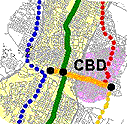
Related Links
Light Rail Now! |
URBAN FREEWAYS DON'T PAY This essay was written in 1989 when E.L. Tennyson, was head planner for the Arlington County, Virginia Public Works Department before Congress increased the gasoline tax from 9¢ a gallon to 18¢ per gallon and reduced the federal share of freeway projects from 90% to 80% with the passage of the intermodal Surface Transportation and Efficiency Act (ISTEA) in 1991. Discussion here reveals how we fail to accurately account for costs when considering modes and what this failure means for the country.
When interstate 95 was being planned through the City of Philadelphia over 30 years ago, it became apparent that there was no hope the superhighway would be a sound undertaking, financially or ecologically. The (then) four cent federal gasoline tax would not begin to cover anything close to the 30 percent federal share, the City would lose heavily on valuable property removed from the tax rolls, and the parallel railroad and transit lines would no longer be able to operate without subsidy as the subsidized new road diverted some of the travel (and revenue). Despite the bleak prospect and strong opposition, the road was pushed thorough, and the consequences have been suffered. Much has changed in thirty years, but freeway economics has not. "The more things change, the more they stay the same." Despite the increase in the federal gasoline tax from four to nine cents, interstate 696, recently (1989) completed 28 miles across the northern tier of Detroit for $ 675 million, suffers the same economic losses as I-95, The Delaware Expressway, has for thirty years in Philadelphia. There is no credibility to the belief that such highways "pay their way" from the Highway Trust Fund. The table below estimates the huge economic losses associated with typical urban/suburban freeways such as I-95 in several major cities and I-696 near Detroit, using a typical mile of I-696 as the most recent example: ECONOMIC ANALYSIS OF A MILE OF I-696 Highway engineers include the value of time saved on an interstate as a justification for paying for them. In 1989, such time was worth about six cents per minute based upon diversion studies where choices were available. Truckers are credited with a much larger saving of fictitious money. The problem with this credit is that it represents no actual source of funds with which to build or maintain a highway. The credit is imaginary cash. The costs must be paid with real money. With inadequate gasoline taxes and no tolls, the money must come from deferred maintenance inadequate policing, higher property and/or sales taxes for local roads, or other non-highway revenue source, diverting funds from more urgent needs. Such a direct subsidy to the trucking industry is very poor and inequitable public policy. It is destroying more efficient means of transportation. If public mass transit projects were credited with the same value of time saved, the renowned San Diego Trolley (North America's most economically successful: transit project since the inception of the interstate highway program would earn almost $19 million per year on its initial South Bay (Tijuana) line which costs but $1 million per year to maintain and operate. The trolley would be profitable with free fares. The deceptive irrationality of using time saved to "pay" for highway projects should be obvious. If it is not obvious, then public transit projects should be credited with the same time saving value. This nation faces severe economic and environmental problems including deteriorating transportation infrastructure, burgeoning public debt, loss of productivity, balance of payments deficits, environmental degradation, suburban traffic congestion, travel safety, and mobility; for those who at any given moment do not have an expensive vehicle available. This nation must face these problems and mitigate them, or the rest of the world "will bury" us, as Nikita Khrushchev once predicted. Extravagance, uneconomic highway programs, end petroleum dependence are some of our worst excesses, but the solution is simple--toll roads. The Dulles Toll Road (Va. 267) in Northern Virginia and the Garden State Parkway in New Jersey are good examples. People will pay if they want the improved service and there is no free alternative. When people pay it better allocates resources and restores our economy to a better balance. The laws of economics can not be repealed, as the Communists have finally learned. SOURCES: Mr. Tennyson was Deputy Secretary of the Pennsylvania Department of Transportation, 1972-79 and Deputy Commissioner for Transit Engineering for the City of Philadelphia 1968-1971. (City Transit Engineer 1956-67) *E.L. Tennyson retired from Arlington County Public Works in 1992 after 50 years in the transit industry. He lives in Vienna, Virginia. Tennyson is widely cited in the literature. .
|
|
|
|
||